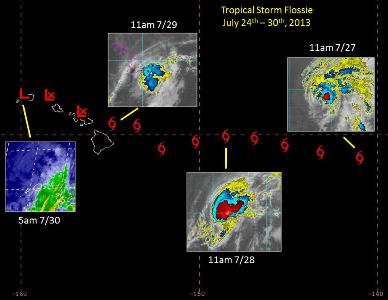North Atlantic
July 2013 Tropical Cyclone Counts
| Storm Type | July 2013 | July 1981-2010 Average | Record Most for July Period of Record: 1851-2013 |
|---|---|---|---|
| Tropical Strorm (Winds > 39 mph) |
2 | 1.1 |
5 (2005) |
| Hurricane (Winds > 74 mph) |
0 | 0.4 |
3 (1916, 1966, 2005) |
| Major Hurricane (Winds > 111 mph) |
0 | 0.1 | 2 (1916, 2005) |
July 2013 Individual Tropcal Cyclones
| Name | Dates of winds >39 mph |
Maximum Sustained Winds |
Minimum Central Pressure |
Landfall |
|---|---|---|---|---|
| Tropical Storm Chantal | July 8th–10th | 65 mph | 1005 mb | N/A |
| Tropical Storm Dorian | July 24th–27th | 60 mph | 999 mb | N/A |
East Pacific
July 2013 Tropical Cyclone Counts
| Storm Type | July 2013 | July 1981-2010 Average | Record Most for July Period of Record: 1949-2013 |
|---|---|---|---|
| Tropical Strorm (Winds > 39 mph) |
3 | 3.6 | 7 (1985) |
| Hurricane (Winds > 74 mph) |
2 | 1.9 |
4 (1971, 1982, 1990, 1992, 2008) |
| Major Hurricane (Winds > 111 mph) |
0 | 1 |
3 (1978, 1985, 1992) |
July 2013 Individual Tropcal Cyclones
| Name | Dates of winds >39 mph |
Maximum Sustained Winds |
Minimum Central Pressure |
Landfall |
|---|---|---|---|---|
| Hurricane Dalia | June 30th–July 4th | 75 mph | 987 mb | N/A |
| Hurricane Erick | July 5th–9th | 80 mph | 984 mb | N/A — Minor impacts along Mexico's Pacific coast. |
| Tropical Storm Flossie | July 25th–30th | 70 mph | 995 mb | N/A — Minor impacts in the Hawaiian Islands |
Tropical Storm Flossie developed from a broad area of low pressure southwest of Acapulco, Mexico on July 25th. The storm traversed a large portion of the eastern and central Pacific Ocean over the course of five days. The storm's intensity peaked with winds of 70 mph on the 27th over open water. The storm weakened as it approached the Hawaiian Islands, and dropped to tropical depression status off the northern coast of Maui on the 30th. Tropical Storm warnings were issued for most of the state, with the expectation of Flossie being the first tropical storm to hit the state since Hurricane Iniki in 1992. This was also the first time tropical storm warnings had been issued for Hawaii since 2007. The storm weakened drastically as it approached Hawaii due to strong wind shear. Rainfall totals generally ranged from 1 to 3 inches in many locations in the state, and contributed to an already wet month. Gusty winds, approaching 50 mph, caused most of the impacts, with downed trees and more than 10,000 homes losing power.
 NOAA's National Centers for Environmental Information
NOAA's National Centers for Environmental Information
